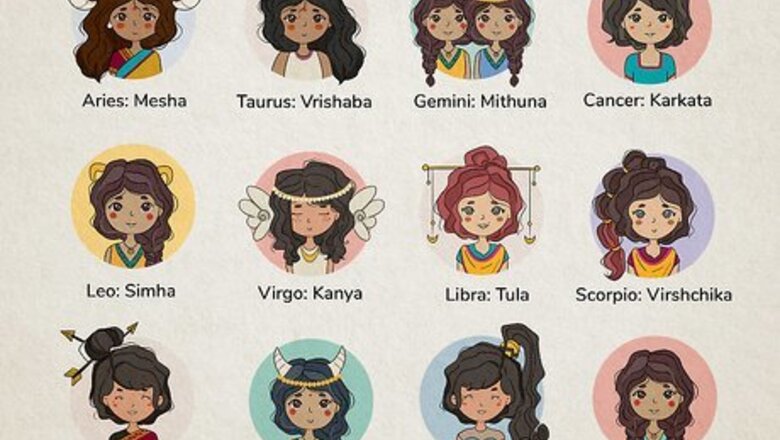
views
Understanding How the Chart is Organized

Locate the signs on the chart. In a South Indian birth chart, the signs always remain in the same position. At the top left of the chart is Pisces, the last sign of the zodiac, and just to the right of it is Aries, the first. The signs then proceed from Aries in a clockwise direction, meaning the sign to the right of Aries is Taurus, then to the right of that is Gemini, and so on. There's different kinds of software you can use to pull up your chart, like Shri Jyoti Star. There are also phone apps that you can use. Vedic signs have different names than their Western counterparts, so if your chart uses the Sanskrit names for the signs (also known as rashis), keep in mind these translations: Aries: Mesha Taurus: Vrishaba Gemini: Mithuna Cancer: Karkata Leo: Simha Virgo: Kanya Libra: Tula Scorpio: Virshchika Sagittarius: Dhanus Capricorn: Makara Aquarius: Kumbha Pisces: Meena
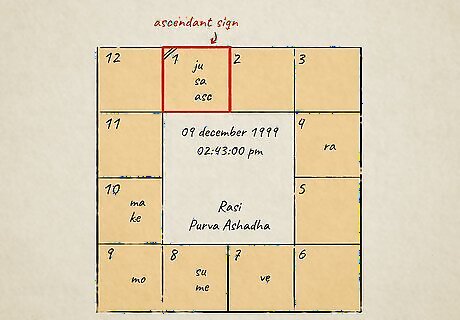
Find the placement of your ascendant. Your ascendant, also known as your rising sign (or in Sanskrit, your lagna), is the most important part of your sidereal chart. As a result, it’s helpfully marked for you on your chart by a slash going through the corner of the sign’s box. When you’re using a birth chart calculator, make sure you input your exact time of birth, since the ascendant changes every couple of hours. Vedic astrology focuses on rising/ascendant signs more than sun signs. A rising sign speaks to a person's nature, how they look, what their personality is like, and what their overall appearance is.
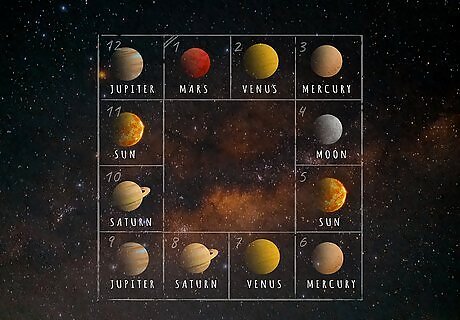
Figure out where your houses are located. Your ascendent is always the first house, and the other houses follow it in a clockwise direction. For example, if your ascendant is in Aquarius (indicated by a slash going through the Aquarius box), this is your first house. The rest of the houses will follow clockwise from this first house. In Vedic astrology, the houses rule over particular domains of your life. They also are ruled over by certain planets, and it’s generally auspicious if these planets are located in their own houses. The houses are as follows: First house: ruled by Mars, this house influences your physical appearance. Second house: ruled by Venus, this house predicts wealth and your family life. Third house: ruled by Mercury, this house influences your intelligence and communication skills. Fourth house: ruled by the Moon, this house influences your domestic life and property. Fifth house: ruled by the Sun, this house makes predictions about your children. Sixth house: ruled by Mercury, this house influences our health and susceptibility to disease. Seventh house: ruled by Venus, this is the house of romantic and business partnerships. Eighth house: ruled by Saturn, this is the house of death, longevity, and sudden surprises. Ninth house: ruled by Jupiter, this is the house of higher education, ethics, and virtue. Tenth house: ruled by Saturn, this house predicts careers and reputations. Eleventh house: ruled by the Sun, this house influences gains in wealth or prestige in your life. Twelfth house: ruled by Jupiter, this house rules over your dreams, secrets, and emotions.
Interpreting Your Planet Positions
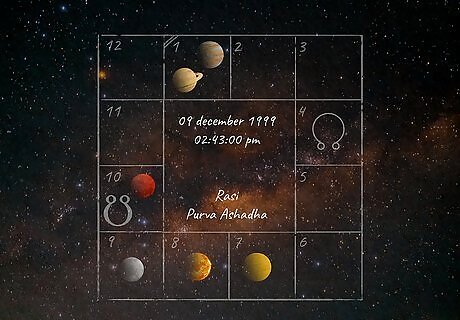
Locate the planets on your chart. Your planets (in Sanskrit, grahas) are distributed throughout your birth chart, and the house they’re in represent certain aspects of your identity. For example, if you have Mercury, the planet of intelligence, located in your third house (the house of communication), you’ll likely be a talented and skilled conversationalist or writer. Each planet is associated with a different aspect of your life, and their names in Sanskrit may be different from what you’re familiar with in Western astrology. Vedic charts often refer to planets by their Sanskrit names, and have numbers underneath each planet indicating their location within the house. Keep the following translations in mind: The Sun: Surya, the planet of your soul or life force. The Moon: Chandra, the planet of your emotions. Mars: Mangal, the planet of aggression and energy. Mercury: Bhuda, the planet of intelligence. Jupiter: Guru, the planet of fortune. Venus: Shukra, the planet of love. Saturn: Shani, the planet of discipline. The Northern Lunar Node: Rahu, the planet of worldly desires. The Southern Lunar Node: Ketu, the planet of loss and liberation.
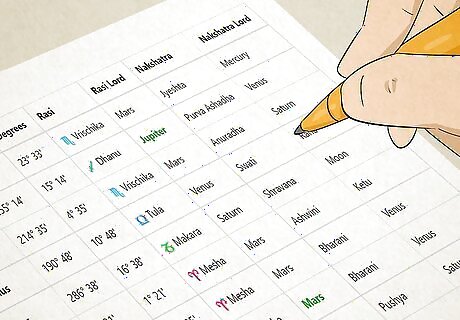
Determine the planets' interactions with their signs. For a simple insight into your birth chart, you can take a look at how comfortable each of your planets are in the signs that they’re located in. When a planet is in a sign that it is most comfortable in, it is “exalted,” which means that its beneficial effects will be more pronounced. The opposite occurs when a planet is in an enemy sign—it loses some of its power, and becomes “debilitated.” The Sun is exalted in Aries and debilitated in Libra. The Moon is exalted in Taurus and debilitated in Scorpio. Jupiter is exalted in Cancer and debilitated in Capricorn. Venus is exalted in Pisces and debilitated in Virgo. Mars is exalted in Capricorn and debilitated in Cancer. Mercury is exalted in Virgo and debilitated in Pisces. Saturn is exalted in Libra and debilitated in Aries. Rahu is exalted in Taurus and Virgo and debilitated in Scorpio and Pisces. Ketu is exalted in Scorpio and Pisces and is debilitated in Taurus and Virgo.

Take a look at your planets’ aspects. The house a planet is placed in is not the only house that it affects. Each planet “aspects” the house 7 places away from it in a clockwise direction, which means that you should consider its influence there as well. For example, if you have an exalted and beneficial moon is in your first house, it will carry its good influence into the 7th house as well. In Vedic astrology, you always include the initial house when you calculate aspects—so the house immediately clockwise to the planet you’re working with is 2 places away from it, not one. Some planets have additional aspects: Jupiter aspects the 5th and 9th houses from it, Mars aspects the 4th and 8th houses from it, and Saturn aspects the 3rd and 10th houses from it.

Look for any retrograde planets. Some Vedic charts will include an “R” next to the name of the planet. This means that the planet is in retrograde. Many Vedic astrologers believe that the results of a retrograde planet are more pronounced: the good effects and bad effects of a planet in retrograde are multiplied. For example, if you have a retrograde Jupiter exalted in Cancer and it’s located in the 9th house (the house of higher education), your academic life will likely be very successful and important to you. Or, if you have a retrograde Sun debilitated in Libra and it’s located in the 4th house (the house of domestic affairs), you might run into some problems managing any property you have or within your family.
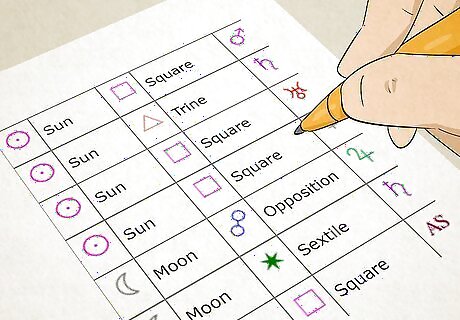
Find any conjunctions in your chart. Conjunctions occur when two or more planets are in the same house. When multiple planets are in the same house, this generally indicates that that house will be a major focus of that person’s life. For example, if Venus, Mercury, and the Sun are all located in your 7th house, seeking and nurturing partnerships will play a major part in your life. As an another example, if you have Saturn and Mars in your 10th house (the house of reputation), your career will be a major focus in your life.




















Comments
0 comment